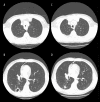Systemic Bevacizumab for Recurrent Respiratory Papillomatosis: A Single Center Experience of Two Cases
- PMID: 28757601
- PMCID: PMC5551929
- DOI: 10.12659/ajcr.904416
Systemic Bevacizumab for Recurrent Respiratory Papillomatosis: A Single Center Experience of Two Cases
Abstract
BACKGROUND Recurrent respiratory papillomatosis (RRP), caused by human papillomavirus (HPV), is the most common benign neoplasm of the larynx and central airways. RRP has a significant impact on quality life and high annual costs to healthcare. Currently, there is no cure for RRP, leading to repeated debulking operations for symptomatic palliation. Various local adjuvant therapies have also been studied with mixed efficacy. HPV oncogene products increase expression of vascular endothelial growth factor (VEGF) providing a potential target for treatment of RRP. Bevacizumab, a recombinant monoclonal antibody that inhibits VEGF, has shown efficacy in patients with localized disease. CASE REPORT We present two cases of extensive airway and parenchymal RRP successfully managed with systemically administered bevacizumab, a recombinant monoclonal antibody that inhibits VEGF. CONCLUSIONS Bevacizumab has shown efficacy in patients with localized disease, but here we illustrate the potential of bevacizumab for patients with extensive parenchymal burden as well as provide a brief review of the literature.
Conflict of interest statement
There are no conflicts of interest.
Figures


Similar articles
-
Outcomes of bevacizumab and cidofovir treatment in HPV-associated recurrent respiratory papillomatosis - review of the literature.Otolaryngol Pol. 2018 Jun 12;72(4):1-8. doi: 10.5604/01.3001.0012.0484. Otolaryngol Pol. 2018. PMID: 30190442 Review.
-
Aggressive recurrent respiratory papillomatosis: A series of five consecutive patients successfully treated with adjuvant intravenous bevacizumab. A single Belgian academic center experience.Head Neck. 2023 May;45(5):1071-1079. doi: 10.1002/hed.27300. Epub 2023 Feb 25. Head Neck. 2023. PMID: 36840929
-
Recurrent respiratory papillomatosis: role of bevacizumab and HPV vaccination. A literature review with case presentations.Radiol Oncol. 2025 Feb 27;59(1):23-30. doi: 10.2478/raon-2025-0010. eCollection 2025 Mar 1. Radiol Oncol. 2025. PMID: 40014785 Free PMC article. Review.
-
Systemic bevacizumab for end-stage juvenile recurrent respiratory papillomas: A case report.Int J Pediatr Otorhinolaryngol. 2020 Jan;128:109706. doi: 10.1016/j.ijporl.2019.109706. Epub 2019 Oct 8. Int J Pediatr Otorhinolaryngol. 2020. PMID: 31610441
-
Systemic bevacizumab as adjuvant therapy for recurrent respiratory papillomatosis in children: A series of three pediatric cases and literature review.Am J Otolaryngol. 2021 Sep-Oct;42(5):103126. doi: 10.1016/j.amjoto.2021.103126. Epub 2021 Jun 24. Am J Otolaryngol. 2021. PMID: 34175693 Review.
Cited by
-
Systemic Bevacizumab for Recurrent Respiratory Papillomatosis: A Scoping Review from 2009 to 2022.Children (Basel). 2022 Dec 26;10(1):54. doi: 10.3390/children10010054. Children (Basel). 2022. PMID: 36670605 Free PMC article.
-
Recurrent respiratory papillomatosis: A 2020 perspective.Laryngoscope Investig Otolaryngol. 2021 Mar 13;6(2):340-345. doi: 10.1002/lio2.545. eCollection 2021 Apr. Laryngoscope Investig Otolaryngol. 2021. PMID: 33869767 Free PMC article. Review.
-
How Enhancing Immunity to Low-Risk HPV Could Cure Recurrent Respiratory Papillomatosis.Laryngoscope. 2021 Sep;131(9):2041-2047. doi: 10.1002/lary.29153. Epub 2021 Mar 15. Laryngoscope. 2021. PMID: 33720393 Free PMC article. Review.
-
Airway Papillomatosis: New Treatments for an Old Challenge.Front Pediatr. 2019 Sep 18;7:383. doi: 10.3389/fped.2019.00383. eCollection 2019. Front Pediatr. 2019. PMID: 31620412 Free PMC article. Review.
-
[Research progress in the adjunct therapy of recurrent respiratory papillomatosis].Lin Chuang Er Bi Yan Hou Tou Jing Wai Ke Za Zhi. 2020 Dec;34(12):1145-1148. doi: 10.13201/j.issn.2096-7993.2020.12.022. Lin Chuang Er Bi Yan Hou Tou Jing Wai Ke Za Zhi. 2020. PMID: 33254355 Free PMC article. Review. Chinese.
References
-
- Pim D, Banks L. Interaction of viral oncoproteins with cellular target molecules: Infection with high-risk vs low-risk human papillomaviruses. APMIS. 2010;118:471–93. - PubMed
-
- Derkay CS, Wiatrak B. Recurrent respiratory papillomatosis: A review. Laryngoscope. 2008;118:1236–47. - PubMed
-
- Lee LA, Cheng AJ, Fang TJ, et al. High incidence of malignant transformation of laryngeal papilloma in Taiwan. Laryngoscope. 2008;118:50–55. - PubMed
-
- Loizou C, Laurell G, Lindquist D, et al. Voice and quality of life in patients with recurrent respiratory papillomatosis in a northern Sweden cohort. Acta Otolaryngol. 2014;134(4):401–6. - PubMed
-
- Derkay C. Task Force on Recurrent Respiratory Papillomas: A preliminary report. Arch Otolaryngol Head Neck Surg. 1995;121:1386–91. - PubMed
Publication types
MeSH terms
Substances
Supplementary concepts
LinkOut - more resources
Full Text Sources

